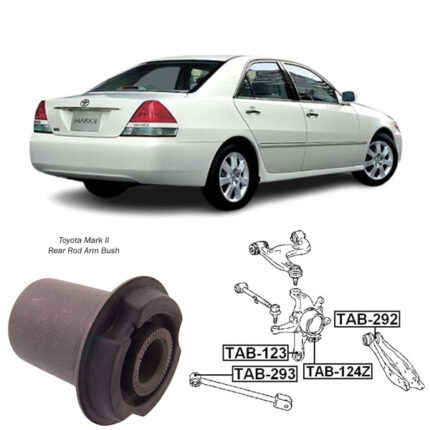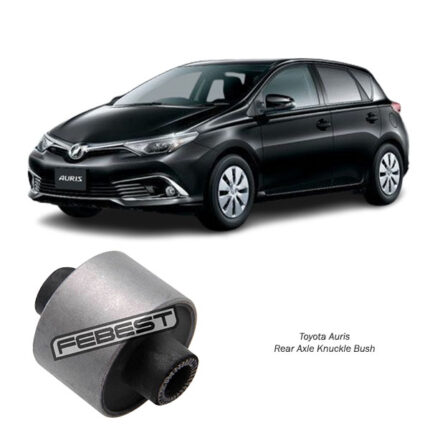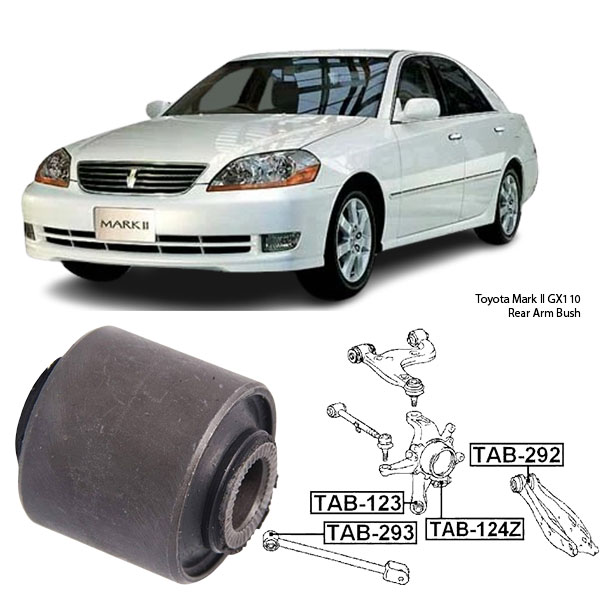-20%
Get Toyota Mark II GX110 Rear Arm Bush TAB-293 in Kenya
The rear arm bush is a crucial component of a vehicle’s suspension system, playing a vital role in ensuring a smooth and stable ride. Often overlooked, this small yet essential part absorbs shocks, reduces vibrations, and maintains proper wheel alignment. Found in the rear control arms, trailing arms, or suspension links, the rear arm bush significantly impacts a vehicle’s handling, comfort, and overall driving experience.
This guide delves into the details of rear arm bushings, exploring their functions, types, benefits, common issues, maintenance tips, and replacement guidelines.
Functions of Rear Arm Bushings
Rear arm bushings serve multiple functions, including:
- Absorbing Vibrations: By cushioning the connection between suspension components, rear arm bushings minimize vibrations transmitted from the road to the vehicle’s chassis.
- Enhancing Ride Comfort: By reducing harsh road shocks, these bushings contribute to a smoother and more comfortable ride.
- Maintaining Wheel Alignment: Bushings help keep the wheels in the correct position, ensuring even tire wear and stable handling.
- Reducing Noise: They prevent metal-on-metal contact between suspension parts, reducing road noise and improving cabin quietness.
- Improving Suspension Performance: Properly functioning bushings enhance the overall efficiency of the suspension system, leading to better traction and control.
Types of Rear Arm Bushings
Rear arm bushings are available in different materials, each offering distinct advantages:
- Rubber Bushings:
- Most common type, found in OEM (Original Equipment Manufacturer) setups.
- Provides excellent vibration dampening and ride comfort.
- Can wear out over time due to exposure to heat, moisture, and road contaminants.
- Polyurethane Bushings:
- Offer improved durability and performance over rubber bushings.
- More resistant to wear and tear but can be slightly stiffer, leading to a firmer ride.
- Ideal for performance-oriented vehicles.
- Metal Bushings:
- Less common in everyday vehicles but used in racing and heavy-duty applications.
- Provide maximum rigidity but offer little vibration absorption.
Common Signs of Worn Rear Arm Bushings
As rear arm bushings degrade, they can cause various issues that affect the vehicle’s performance. Here are some common symptoms of worn-out bushings:
- Clunking or Knocking Noises: Loose or deteriorated bushings may cause knocking sounds when driving over bumps or during acceleration and braking.
- Increased Vibrations: Excessive vibrations in the cabin or steering wheel may indicate failing bushings.
- Poor Handling and Stability: Worn bushings affect suspension alignment, leading to instability, reduced cornering ability, and wandering steering.
- Uneven Tire Wear: Misaligned wheels due to failing bushings can cause premature tire wear and reduced lifespan.
- Braking Instability: If the vehicle sways or feels unstable during braking, the rear arm bushings may be deteriorating.
Causes of Rear Arm Bushing Wear
Several factors contribute to the wear and tear of rear arm bushings:
- Aging and Drying: Rubber bushings naturally degrade over time due to heat, moisture, and environmental exposure.
- Excessive Load and Pressure: Carrying heavy loads or driving aggressively can put additional strain on the bushings.
- Road Conditions: Driving on rough terrain, potholes, and bumpy roads can accelerate bushing wear.
- Oil and Chemical Exposure: Contact with oil, grease, and road chemicals can break down rubber bushings more quickly.
Maintenance Tips for Rear Arm Bushings
To extend the lifespan of rear arm bushings and maintain vehicle performance, follow these maintenance tips:
- Regular Inspections: Check for cracks, tears, or signs of wear in the bushings during routine vehicle servicing.
- Keep Suspension Clean: Avoid buildup of dirt and grime, as they can accelerate wear and tear.
- Use Lubrication: If applicable, use grease or specialized lubricants to reduce friction and prevent premature aging.
- Avoid Overloading: Keep within recommended weight limits to reduce strain on the suspension system.
- Drive Carefully: Avoid rough roads and aggressive driving to minimize excessive impact on the bushings.
Replacing Rear Arm Bushings
When rear arm bushings wear out, they must be replaced to restore vehicle performance and safety. The replacement process generally involves the following steps:
- Lift the Vehicle: Use a jack and jack stands to safely elevate the car.
- Remove the Control Arm or Suspension Link: Unbolt the rear control arm to access the bushings.
- Press Out the Old Bushings: Use a press tool or bushing removal tool to remove worn-out bushings.
- Install the New Bushings: Press in the new bushings, ensuring a snug fit.
- Reassemble and Tighten: Reattach the control arm and tighten all bolts to manufacturer specifications.
- Perform Wheel Alignment: A wheel alignment is recommended after replacing suspension components to ensure proper tracking and tire wear.
OEM vs. Aftermarket Rear Arm Bushings
When replacing rear arm bushings, you can choose between OEM (Original Equipment Manufacturer) and aftermarket parts:
- OEM Bushings:
- Designed specifically for your vehicle model.
- Offer the best ride comfort and durability.
- Typically more expensive but ensure a factory-like performance.
- Aftermarket Bushings:
- Available in a variety of materials (rubber, polyurethane, etc.).
- May offer better performance and durability, depending on the brand.
- Some may require modifications for proper fitment.
Conclusion
The rear arm bush is a small but essential component of a vehicle’s suspension system, influencing ride comfort, stability, and overall performance. Regular inspections and timely replacements ensure a smoother and safer driving experience. Whether you opt for rubber, polyurethane, or metal bushings, choosing the right type based on your driving needs is crucial.
By understanding the functions, common issues, maintenance tips, and replacement procedures of rear arm bushings, vehicle owners can make informed decisions and keep their suspension system in top shape for years to come.
Follow us on Facebook for more parts.



